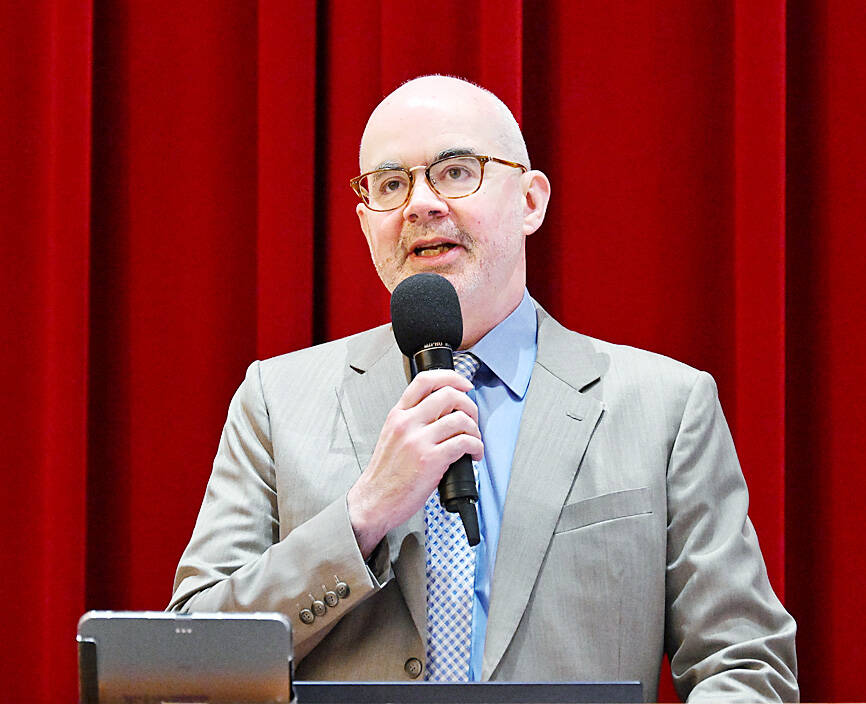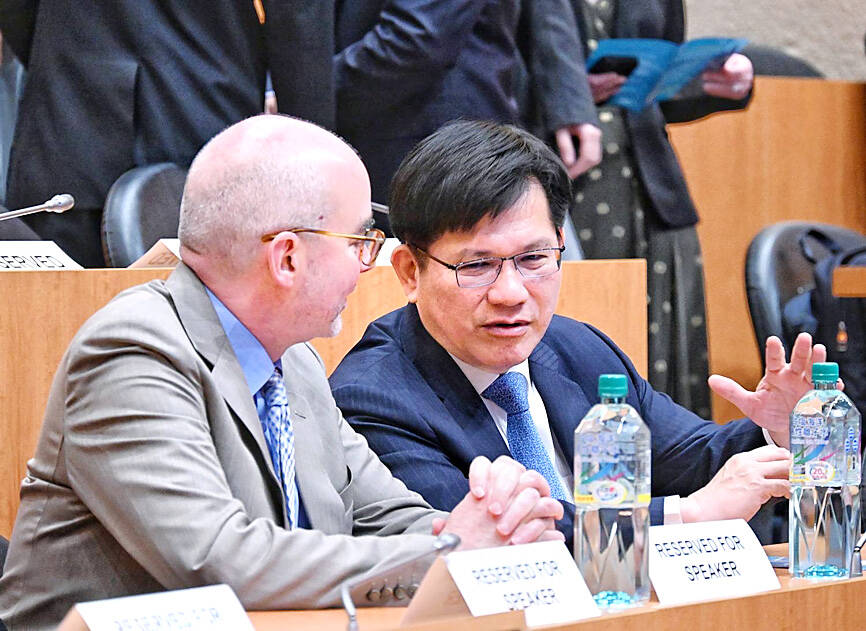American Institute in Taiwan (AIT) Director Raymond Greene yesterday reiterated that the US stands with its allies and partners in the Indo-Pacific region, adding that cooperation is more critical than ever.
Greene made the comments during his congratulatory remarks at the “Taiwan Forward: Driving Modernization Amid Shifting Global Dynamics” conference at National Taiwan University (NTU) in Taipei.
“The United States stands strong with our allies and partners in the Indo-Pacific,” he said. “We’re taking decisive actions to counter threats against economic resilience and advanced shared interests.”

Photo: Fang Pin-chao, Taipei Times
“Our cooperation is more critical than ever,” he said, adding that it makes “the US, Taiwan and all of our regional allies safer, stronger and more prosperous,” referring to remarks by the Minister of Foreign Affairs Lin Chia-lung (林佳龍).
While many countries have recognized Taiwan as a beacon of universal values and support the nation’s resilience and international participation, it has also in the past decade significantly reduced its investments in China, moving them to like-minded democratic countries, Greene said.
However, Taiwan still faces challenges, such as leading in artificial intelligence (AI), but falling behind in software development, which is partially due to reasonable concerns over China’s infiltration of Chinese-language large language models, he said.

Photo: Fang Pin-chao, Taipei Times
Greene also addressed the nation’s security “in the face of a relentlessly aggressive China that is using the full range of military, economic and diplomatic tools against Taiwan.”
“The United States has a stake in these questions and in Taiwan’s success,” he said, adding that the US and Taiwan are leading partners in advanced technology development, while the number of Taiwanese students studying in the US is growing and Taiwan is the US’ seventh-largest trading partner.
“Maintaining the status quo in the Taiwan Strait is critical for the United States and the entire world,” the AIT director said.
Citing comments by US Secretary of State Marco Rubio, Greene said the US has a long-standing position on Taiwan that it would not abandon, which is that “we are against any forced, compelled, coercive change in the status of Taiwan.”
“The challenges Taiwan faces are not only challenges for Taiwan, but for the United States, and the entire world,” he said. “A strong, resilient Taiwan, and a stable and peaceful Indo-Pacific are the foundations of modernization.”
The conference — organized by the Taiwan Program at Stanford University’s Walter H. Shorenstein Asia-Pacific Research Center and cosponsored by NTU’s Office of International Affairs — featured panel discussions with academics from Stanford University, NTU and other universities in Taiwan, Japan, South Korea and Singapore, alongside Taiwanese industry leaders, on topics ranging from AI innovation and semiconductor, entrepreneurship, biomedical and healthcare advancements, and Taiwan’s demographic transformation.
Additional reporting by CNA

The US government has signed defense cooperation agreements with Japan and the Philippines to boost the deterrence capabilities of countries in the first island chain, a report by the National Security Bureau (NSB) showed. The main countries on the first island chain include the two nations and Taiwan. The bureau is to present the report at a meeting of the legislature’s Foreign Affairs and National Defense Committee tomorrow. The US military has deployed Typhon missile systems to Japan’s Yamaguchi Prefecture and Zambales province in the Philippines during their joint military exercises. It has also installed NMESIS anti-ship systems in Japan’s Okinawa

‘WIN-WIN’: The Philippines, and central and eastern European countries are important potential drone cooperation partners, Minister of Foreign Affairs Lin Chia-lung said Minister of Foreign Affairs Lin Chia-lung (林佳龍) in an interview published yesterday confirmed that there are joint ventures between Taiwan and Poland in the drone industry. Lin made the remark in an exclusive interview with the Chinese-language Liberty Times (the Taipei Times’ sister paper). The government-backed Taiwan Excellence Drone International Business Opportunities Alliance and the Polish Chamber of Unmanned Systems on Wednesday last week signed a memorandum of understanding in Poland to develop a “non-China” supply chain for drones and work together on key technologies. Asked if Taiwan prioritized Poland among central and eastern European countries in drone collaboration, Lin

The Chien Feng IV (勁蜂, Mighty Hornet) loitering munition is on track to enter flight tests next month in connection with potential adoption by Taiwanese and US armed forces, a government source said yesterday. The kamikaze drone, which boasts a range of 1,000km, debuted at the Taipei Aerospace and Defense Technology Exhibition in September, the official said on condition of anonymity. The Chungshan Institute of Science and Technology and US-based Kratos Defense jointly developed the platform by leveraging the engine and airframe of the latter’s MQM-178 Firejet target drone, they said. The uncrewed aerial vehicle is designed to utilize an artificial intelligence computer

Renewed border fighting between Thailand and Cambodia showed no signs of abating yesterday, leaving hundreds of thousands of displaced people in both countries living in strained conditions as more flooded into temporary shelters. Reporters on the Thai side of the border heard sounds of outgoing, indirect fire yesterday. About 400,000 people have been evacuated from affected areas in Thailand and about 700 schools closed while fighting was ongoing in four border provinces, said Thai Rear Admiral Surasant Kongsiri, a spokesman for the military. Cambodia evacuated more than 127,000 villagers and closed hundreds of schools, the Thai Ministry of Defense said. Thailand’s military announced that